|
PART 1:
MANUFACTURING THE SLIDES
The beginning
Silhouettes
Handpainted slides
Transparent paints
Artists
Methods of production
Subjects
Decalcomania
Transfer
Serial production
Do-it-yourself
Transparencies
Wet plate period
Woodbury-print
Living figures
Photograms
Special methods
PART 2:
SINGLE LANTERN SLIDES
Mounted in wood frames
Kinds of wood
Long strips of glass
Frames
Lack of normalization
Circle shaped pictures
Panorama slides
Sets
8,3 x 8,3 cm size
World size
Series
Primus Junior Lecturers
Projektion für Alle
Enclosed textbooks
Round, disc shaped slides and other sizes
PART 3:
MULTIPLE SLIDES
Moving pictures
Musschenbroek
Mechanisms
Pivotted-lever slides
Slipping slide
Changing landscapes
Jumping images
Dissolving views
Falling snow
Chromatropes
David Brewster
Caleidoscope
Eidotrope
Cycloidotrope
|
MULTIPLE SLIDES
Mechanical slides:
Even Kircher thought up various tricks allowing his projected shadows to
move. Around 1736 the first composite, mechanical movable slides were
constructed. In 'Elementa Physices', the Latin book written by the Dutch
professor Pieter van
Musschenbroek (1692-1761), we find descriptions of this type of
slides.
 Probably
he got help from his brother Jan, who was an instrument maker. The two
brothers invented and manufactured different mechanized devices for, among
other things, a turning movement by means of a string or a small bar,
fastened to the second glass, on which the moving part of the picture had
been painted. An up and down movement within a picture was realized by
attaching a pivoted lever to the second glass. In Germany these slides
were called 'Hebelbilder'. Example: a little ship bobbing on the
sea. On the fixed glass the sea had been pained; the ship was on the
movable one. Probably
he got help from his brother Jan, who was an instrument maker. The two
brothers invented and manufactured different mechanized devices for, among
other things, a turning movement by means of a string or a small bar,
fastened to the second glass, on which the moving part of the picture had
been painted. An up and down movement within a picture was realized by
attaching a pivoted lever to the second glass. In Germany these slides
were called 'Hebelbilder'. Example: a little ship bobbing on the
sea. On the fixed glass the sea had been pained; the ship was on the
movable one.
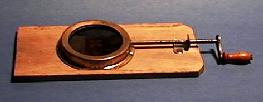 Mechanical
slides were introduced in various sizes and types. Among the were very complicated
specimens, some with more than two glasses put on the top of each other,
which could be turned in respect of each other by means of a mechanical
device. We even know of a specimen consisting of five slides put on each
other. Mechanical
slides were introduced in various sizes and types. Among the were very complicated
specimens, some with more than two glasses put on the top of each other,
which could be turned in respect of each other by means of a mechanical
device. We even know of a specimen consisting of five slides put on each
other.
Apart from the slides which moved by
turning round or by means of a pivoted lever, there were also slipping
slides in various sizes and
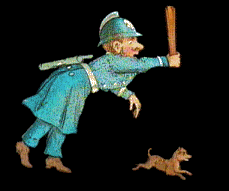 designs.
In this case the impression of movement is produced by sliding one glass in
front of the other. The movable glass, or 'slipping glass' can be pulled
partly out the frame, or pushed in to its former position. Changes or
movements may be effected by alternately masking off one and then another
part of the subject, for example two positions of the arm of a policeman
chasing away a little dog. The subject may also be represented partly on the
fixed glass and partly on the slipping glass; that's how the performer was
able to let roll the pupils in the eyes of an angry schoolteacher. designs.
In this case the impression of movement is produced by sliding one glass in
front of the other. The movable glass, or 'slipping glass' can be pulled
partly out the frame, or pushed in to its former position. Changes or
movements may be effected by alternately masking off one and then another
part of the subject, for example two positions of the arm of a policeman
chasing away a little dog. The subject may also be represented partly on the
fixed glass and partly on the slipping glass; that's how the performer was
able to let roll the pupils in the eyes of an angry schoolteacher.
There were also pictures with
passing movements, commonly defined as 'single panoramic slides', using
two glasses, one passing in front of the other in a lateral direction. The
frame with the fixed glass remains stationary in the lantern while the
long movable glass is drawn past the slide aperture. Example: A glass
depicting a herd of animals or a procession of monks was slowly drawn away
along the background slide, showing the surroundings.
At the same time we still know the 'changing
images' (German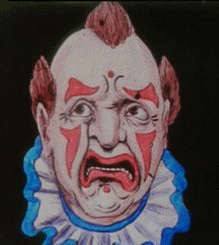 equivalent: Verwandlungsbilder). In this case a type of slide was
concerned which was changed very quickly in the course of the projection.
This action produced a motional effect, due to the "persistence of
vision.", just like the film (also read 'Discs
and Drums'). Those parts of the image which had to be changed were
sometimes also placed side by side on one glass strip and quickly drawn
back and forth.
equivalent: Verwandlungsbilder). In this case a type of slide was
concerned which was changed very quickly in the course of the projection.
This action produced a motional effect, due to the "persistence of
vision.", just like the film (also read 'Discs
and Drums'). Those parts of the image which had to be changed were
sometimes also placed side by side on one glass strip and quickly drawn
back and forth.
Dissolving
views:
These slides were made for exclusive use on a lantern with two or more
lenses. The very first dissolving views were hand-painted pictures of e.g. a
little church in a beautiful summary landscape. A second slide was showing
the same church, but then in a wintry scenery. By dissolving these two views
slowly, the transition of the seasons was visualized. For that purpose often
a mechanical device had been fitted on the magic lantern, which locked up
the first diaphragm slowly whilst the second was opened simultaneously. The
effect could be enhanced furthermore by applying a 'snow-fall device',
consisting of a small wooden panel with a circular round cut-away of the
same size as the accompanying slides. A roll of black paper with small holes
could be drawn over the diaphragm by turning round a handle. This appliance
was fixed in a second magic lantern, or before the third lens of the first
one. In this way it was possible to imitate the whirling snowflakes most
suggestively during the projection of the 'winter slide'.
Chromatropes
('colour changing slides'):
A very special type of mechanical slide is the chromatrope, developed by Sir
David Brewster in 1846. Two round glasses painted with colour motives are
mounted in the groove of a solid wood frame. Both glasses
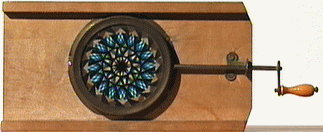 are
free to revolve in relation to the other. The glasses are fixed in a brass
collar with a series of vertical teeth around its upper edge, forming a
rackwork rim. A steel pinion with a matching toothed-end and a handle at
the other end is between the discs. On turning the handle, the double
rackwork is driven round by the pinion, causing the glass discs to revolve
in opposite directions. During the projection this action
produced a highly pleasant and surprising effect, more or less similar to
a kaleidoscope. We are likewise acquainted with chromatropes equipped with
three glasses and chromatropes which were made by placing small beads and
small pieces of coloured glass between two revolving glass discs, just as
done with a kaleidoscope. are
free to revolve in relation to the other. The glasses are fixed in a brass
collar with a series of vertical teeth around its upper edge, forming a
rackwork rim. A steel pinion with a matching toothed-end and a handle at
the other end is between the discs. On turning the handle, the double
rackwork is driven round by the pinion, causing the glass discs to revolve
in opposite directions. During the projection this action
produced a highly pleasant and surprising effect, more or less similar to
a kaleidoscope. We are likewise acquainted with chromatropes equipped with
three glasses and chromatropes which were made by placing small beads and
small pieces of coloured glass between two revolving glass discs, just as
done with a kaleidoscope.
The Eidotrope was a chromatrope
variant using counter-rotating discs of perforated metal, showing a swirling
pattern of brilliant white dots on the screen. Coloured translucent sheets
could be added to tint the display.
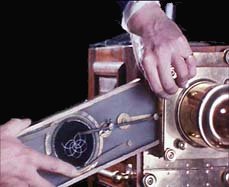 A truly
remarkable variant was the Cycloidotrope, a kind of spirograph. A black
disc of smoked glass rotated within the slide frame, while a stylus on a
pivoted arm traced a pattern in the soot against the moving glass. This
appeared on the screen as a brilliant white line tracing a regular
geometric design with an increasing complexity. The stylus could be reset
while the cycloidotrope was rotated, producing interlocking rosettes and
similar mechanical geometric figures. A truly
remarkable variant was the Cycloidotrope, a kind of spirograph. A black
disc of smoked glass rotated within the slide frame, while a stylus on a
pivoted arm traced a pattern in the soot against the moving glass. This
appeared on the screen as a brilliant white line tracing a regular
geometric design with an increasing complexity. The stylus could be reset
while the cycloidotrope was rotated, producing interlocking rosettes and
similar mechanical geometric figures.
|

 Probably
he got help from his brother Jan, who was an instrument maker. The two
brothers invented and manufactured different mechanized devices for, among
other things, a turning movement by means of a string or a small bar,
fastened to the second glass, on which the moving part of the picture had
been painted. An up and down movement within a picture was realized by
attaching a pivoted lever to the second glass. In Germany these slides
were called 'Hebelbilder'. Example: a little ship bobbing on the
sea. On the fixed glass the sea had been pained; the ship was on the
movable one.
Probably
he got help from his brother Jan, who was an instrument maker. The two
brothers invented and manufactured different mechanized devices for, among
other things, a turning movement by means of a string or a small bar,
fastened to the second glass, on which the moving part of the picture had
been painted. An up and down movement within a picture was realized by
attaching a pivoted lever to the second glass. In Germany these slides
were called 'Hebelbilder'. Example: a little ship bobbing on the
sea. On the fixed glass the sea had been pained; the ship was on the
movable one.  Mechanical
slides were introduced in various sizes and types. Among the were very complicated
specimens, some with more than two glasses put on the top of each other,
which could be turned in respect of each other by means of a mechanical
device. We even know of a specimen consisting of five slides put on each
other.
Mechanical
slides were introduced in various sizes and types. Among the were very complicated
specimens, some with more than two glasses put on the top of each other,
which could be turned in respect of each other by means of a mechanical
device. We even know of a specimen consisting of five slides put on each
other.  designs.
In this case the impression of movement is produced by sliding one glass in
front of the other. The movable glass, or 'slipping glass' can be pulled
partly out the frame, or pushed in to its former position. Changes or
movements may be effected by alternately masking off one and then another
part of the subject, for example two positions of the arm of a policeman
chasing away a little dog. The subject may also be represented partly on the
fixed glass and partly on the slipping glass; that's how the performer was
able to let roll the pupils in the eyes of an angry schoolteacher.
designs.
In this case the impression of movement is produced by sliding one glass in
front of the other. The movable glass, or 'slipping glass' can be pulled
partly out the frame, or pushed in to its former position. Changes or
movements may be effected by alternately masking off one and then another
part of the subject, for example two positions of the arm of a policeman
chasing away a little dog. The subject may also be represented partly on the
fixed glass and partly on the slipping glass; that's how the performer was
able to let roll the pupils in the eyes of an angry schoolteacher.  equivalent: Verwandlungsbilder). In this case a type of slide was
concerned which was changed very quickly in the course of the projection.
This action produced a motional effect, due to the "persistence of
vision.", just like the film (also read '
equivalent: Verwandlungsbilder). In this case a type of slide was
concerned which was changed very quickly in the course of the projection.
This action produced a motional effect, due to the "persistence of
vision.", just like the film (also read ' are
free to revolve in relation to the other. The glasses are fixed in a brass
collar with a series of vertical teeth around its upper edge, forming a
rackwork rim. A steel pinion with a matching toothed-end and a handle at
the other end is between the discs. On turning the handle, the double
rackwork is driven round by the pinion, causing the glass discs to revolve
in opposite directions. During the projection this action
produced a highly pleasant and surprising effect, more or less similar to
a kaleidoscope. We are likewise acquainted with chromatropes equipped with
three glasses and chromatropes which were made by placing small beads and
small pieces of coloured glass between two revolving glass discs, just as
done with a kaleidoscope.
are
free to revolve in relation to the other. The glasses are fixed in a brass
collar with a series of vertical teeth around its upper edge, forming a
rackwork rim. A steel pinion with a matching toothed-end and a handle at
the other end is between the discs. On turning the handle, the double
rackwork is driven round by the pinion, causing the glass discs to revolve
in opposite directions. During the projection this action
produced a highly pleasant and surprising effect, more or less similar to
a kaleidoscope. We are likewise acquainted with chromatropes equipped with
three glasses and chromatropes which were made by placing small beads and
small pieces of coloured glass between two revolving glass discs, just as
done with a kaleidoscope.
 A truly
remarkable variant was the Cycloidotrope, a kind of spirograph. A black
disc of smoked glass rotated within the slide frame, while a stylus on a
pivoted arm traced a pattern in the soot against the moving glass. This
appeared on the screen as a brilliant white line tracing a regular
geometric design with an increasing complexity. The stylus could be reset
while the cycloidotrope was rotated, producing interlocking rosettes and
similar mechanical geometric figures.
A truly
remarkable variant was the Cycloidotrope, a kind of spirograph. A black
disc of smoked glass rotated within the slide frame, while a stylus on a
pivoted arm traced a pattern in the soot against the moving glass. This
appeared on the screen as a brilliant white line tracing a regular
geometric design with an increasing complexity. The stylus could be reset
while the cycloidotrope was rotated, producing interlocking rosettes and
similar mechanical geometric figures.